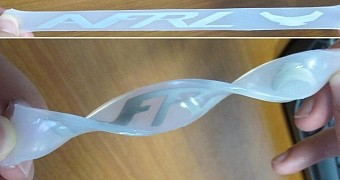After flexible materials that can carry flexible and water resistant transistors have been researched in Japan, the US Military is now also investing in flexible and stretchable materials.
The American Chemical Society is now researching a material that can replace the rigid printed circuit board in guided munition bombs by a ribbon of resilient, high-performance electronics using new 3D printing technologies.
Applications might include inks made of metals, polymers and organic materials to electronically tie the system together. According to their press release, the scientists could take a razor-thin silicon integrated circuit a few nanometers thick and place it on a flexible, bendable plastic-like substrate material.
Whatever you do, don't forget about bombs!
To carry electricity, the team is using liquid gallium alloys injected into the substrate to carry the electricity. Since alloys are never exposed to air, oxidation is successfully prevented. Apparently, the material can be "integrated into complex curved surfaces, such as an airplane’s wing, or even a person’s skin.” One can't ignore how sinister the last part of the military's plan of "integrating circuits under a person's skin" in a military environment sounds like. Are they talking military cyborgs already?
On the other hand, the military plan to use these highly flexible circuit boards in bombs and rockets in order to make them survive the initial shock of being dropped from a plane and still function until a controlled detonation is being ordered. This might be just a first step in a series of multiple developments the military could see using the flexible circuit boards/transistors that are being widely developed around the world.
One can only notice that it didn't take long for this sort of highly advanced material to be imported from tech meant to heat people's clothes and provide smart clothing to equip other more devious smart things like bombs and kill people in the most efficient and controllable fashion as possible.

 14 DAY TRIAL //
14 DAY TRIAL //